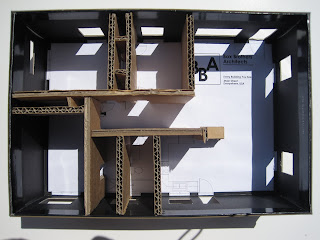We have essentially been designing/building boxes to live inside of since just after the caveman days. So, to demonstrate or represent this, I built a rather crude study model literally using a shoebox (photo 1). The metaphor is quite appropriate since I've actually heard the term used to describe many buildings. We move around all day from box to box (we call "rooms") looking for the cheese but never finding it. These "room" boxes are then all crammed inside bigger boxes (we call "buildings"), which are then crammed next to each other to form cities or "developments". We then "plunk" the shoebox anywhere on every last acre, not caring where because the box isn't site-specific (photos 2-4). Next, we "punch" holes in the box sides and doll them up with trim and decoration, wrapping the whole with ribbons (photo 5). Lastly, if it's a sloping roof we call it a "house", and if it's flat roof we call it a "commercial building". Signage has to be added to remind us which box we're in (photo 6).
The new idea is to break down the box (photo 7) and instead build screens that define space/function instead of confine it. This idea certainly has precedent with Frank Lloyd Wright's "destruction of the box" principle, as well as Mies Van Der Rohe's sliding planes of the Barcelona Pavilion. But I'm for pushing that envelope to an almost more literal interpretation. I'm for a more dynamic site engagement, unlike the indifferent generic box.
Imagine solid screens where necessary reaching out into the landscape and up to the sky , with glass "voids" in between to let space, light, views, and breezes flow entirely through the building (photos 8-?). Maybe some screens extend out from within to become planters, fountains or private terraces (photos ?-?). Even the roof "opens" up with clerestory windows for light, ventilation and views. This is an Organic Modernism (a term I invented that best describes it) freed from the creatively stifling shackles of fixed styles (Tuscany, Spanish Colonial, Santa Barbara, "Old World"??). This closer relationship with the environment will help us reconnect with and appreciate all the beauty of nature we are trying to protect. This new building can better "attach" itself to features/conditions specific to its site, leading to more "sustainable" or "green" solutions.
We've been detached from the landscape far too long, trying to conquer it instead of living integrally with it. It's time for a free architecture that better represents the spirit of Democracy for which this nation was born!














No comments:
Post a Comment